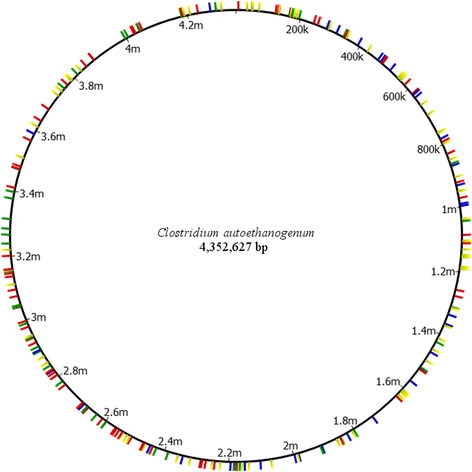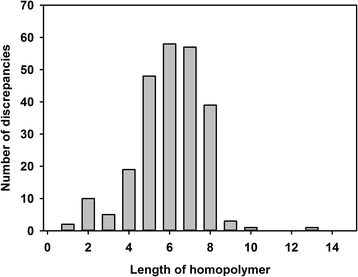Whole genome sequence and manual annotation of Clostridium autoethanogenum, an industrially relevant bacterium
- PMID: 26692227
- PMCID: PMC4687164
- DOI: 10.1186/s12864-015-2287-5
Whole genome sequence and manual annotation of Clostridium autoethanogenum, an industrially relevant bacterium
Abstract
Background: Clostridium autoethanogenum is an acetogenic bacterium capable of producing high value commodity chemicals and biofuels from the C1 gases present in synthesis gas. This common industrial waste gas can act as the sole energy and carbon source for the bacterium that converts the low value gaseous components into cellular building blocks and industrially relevant products via the action of the reductive acetyl-CoA (Wood-Ljungdahl) pathway. Current research efforts are focused on the enhancement and extension of product formation in this organism via synthetic biology approaches. However, crucial to metabolic modelling and directed pathway engineering is a reliable and comprehensively annotated genome sequence.
Results: We performed next generation sequencing using Illumina MiSeq technology on the DSM10061 strain of Clostridium autoethanogenum and observed 243 single nucleotide discrepancies when compared to the published finished sequence (NCBI: GCA_000484505.1), with 59.1 % present in coding regions. These variations were confirmed by Sanger sequencing and subsequent analysis suggested that the discrepancies were sequencing errors in the published genome not true single nucleotide polymorphisms. This was corroborated by the observation that over 90 % occurred within homopolymer regions of greater than 4 nucleotides in length. It was also observed that many genes containing these sequencing errors were annotated in the published closed genome as encoding proteins containing frameshift mutations (18 instances) or were annotated despite the coding frame containing stop codons, which if genuine, would severely hinder the organism's ability to survive. Furthermore, we have completed a comprehensive manual curation to reduce errors in the annotation that occur through serial use of automated annotation pipelines in related species. As a result, different functions were assigned to gene products or previous functional annotations rejected because of missing evidence in various occasions.
Conclusions: We present a revised manually curated full genome sequence for Clostridium autoethanogenum DSM10061, which provides reliable information for genome-scale models that rely heavily on the accuracy of annotation, and represents an important step towards the manipulation and metabolic modelling of this industrially relevant acetogen.
Figures



Similar articles
-
Reconstruction of Acetogenesis Pathway Using Short-Read Sequencing of Clostridium aceticum Genome.J Nanosci Nanotechnol. 2015 May;15(5):3852-61. doi: 10.1166/jnn.2015.9537. J Nanosci Nanotechnol. 2015. PMID: 26505015
-
Comparison of single-molecule sequencing and hybrid approaches for finishing the genome of Clostridium autoethanogenum and analysis of CRISPR systems in industrial relevant Clostridia.Biotechnol Biofuels. 2014 Mar 21;7:40. doi: 10.1186/1754-6834-7-40. eCollection 2014. Biotechnol Biofuels. 2014. PMID: 24655715 Free PMC article.
-
Manual curation and reannotation of the genomes of Clostridium difficile 630Δerm and C. difficile 630.J Med Microbiol. 2017 Mar;66(3):286-293. doi: 10.1099/jmm.0.000427. J Med Microbiol. 2017. PMID: 28357980
-
Progress towards platform chemical production using Clostridium autoethanogenum.Biochem Soc Trans. 2018 Jun 19;46(3):523-535. doi: 10.1042/BST20170259. Epub 2018 Apr 17. Biochem Soc Trans. 2018. PMID: 29666216 Review.
-
Recent progress in engineering Clostridium autoethanogenum to synthesize the biochemicals and biocommodities.Synth Syst Biotechnol. 2023 Dec 15;9(1):19-25. doi: 10.1016/j.synbio.2023.12.001. eCollection 2024 Mar. Synth Syst Biotechnol. 2023. PMID: 38205027 Free PMC article. Review.
Cited by
-
Gas Fermentation-A Flexible Platform for Commercial Scale Production of Low-Carbon-Fuels and Chemicals from Waste and Renewable Feedstocks.Front Microbiol. 2016 May 11;7:694. doi: 10.3389/fmicb.2016.00694. eCollection 2016. Front Microbiol. 2016. PMID: 27242719 Free PMC article. Review.
-
Dietary Effect of Clostridium autoethanogenum Protein on Growth, Intestinal Histology and Flesh Lipid Metabolism of Largemouth Bass (Micropterus salmoides) Based on Metabolomics.Metabolites. 2022 Nov 9;12(11):1088. doi: 10.3390/metabo12111088. Metabolites. 2022. PMID: 36355171 Free PMC article.
-
A Gold Standard, CRISPR/Cas9-Based Complementation Strategy Reliant on 24 Nucleotide Bookmark Sequences.Genes (Basel). 2020 Apr 23;11(4):458. doi: 10.3390/genes11040458. Genes (Basel). 2020. PMID: 32340238 Free PMC article.
-
Effects of Fishmeal Replacement by Clostridium Autoethanogenum Protein Meal on Cholesterol Bile Acid Metabolism, Antioxidant Capacity, Hepatic and Intestinal Health of Pearl Gentian Grouper (Epinephelus Fuscoguttatus ♀ × Epinephelus Lanceolatus ♂).Animals (Basel). 2023 Mar 18;13(6):1090. doi: 10.3390/ani13061090. Animals (Basel). 2023. PMID: 36978631 Free PMC article.
-
Complete Genome Sequence of Cupriavidus necator H16 (DSM 428).Microbiol Resour Announc. 2019 Sep 12;8(37):e00814-19. doi: 10.1128/MRA.00814-19. Microbiol Resour Announc. 2019. PMID: 31515345 Free PMC article.
References
-
- Sims R, Taylor M, Sadler J, Mabee W. From 1st- to 2nd-generation biofuels technologies. Paris: International Energy Agency (IEA) and Organisation for Economic Co-Operation and Development; 2008.
-
- The State of Food Insecurity in the World 2008. The State of Food Insecurity in the World . High food prices and food security – threats and opportunities. Rome: Food and Agriculture Organization of the United Nations; 2008.
Publication types
MeSH terms
Associated data
Grants and funding
LinkOut - more resources
Full Text Sources
Other Literature Sources
Molecular Biology Databases
Research Materials

